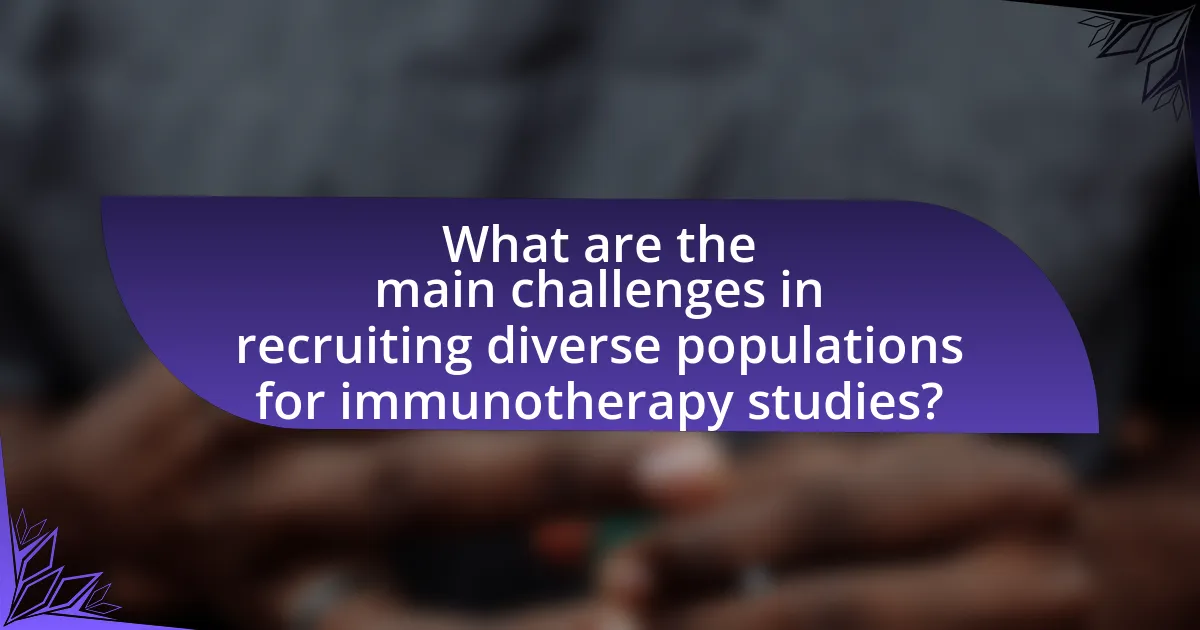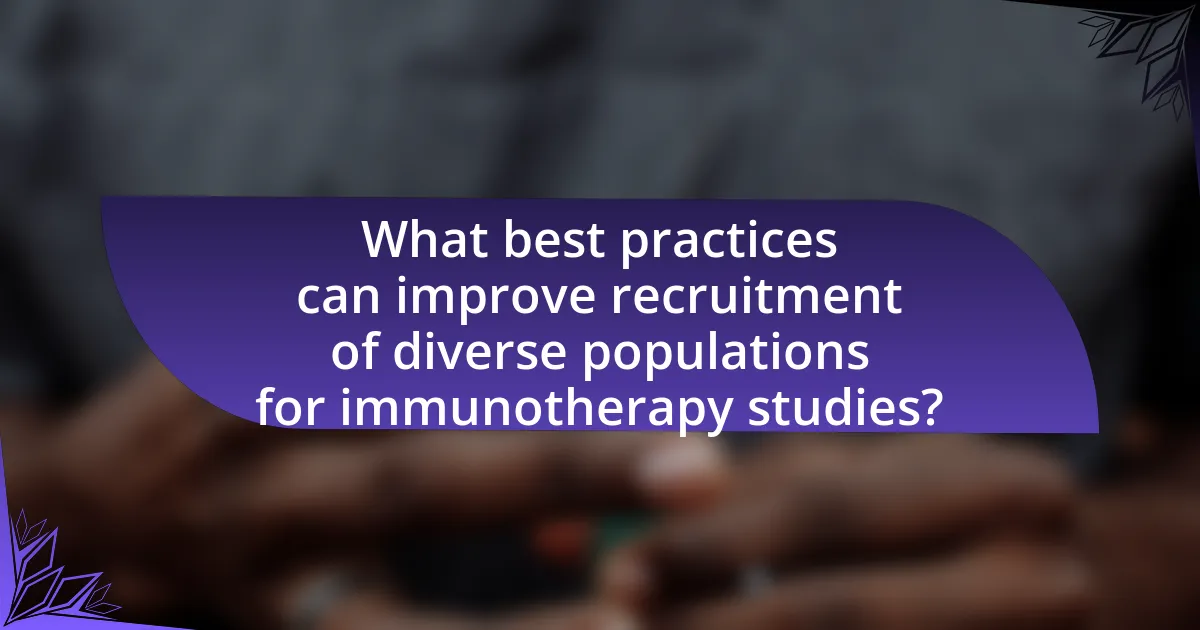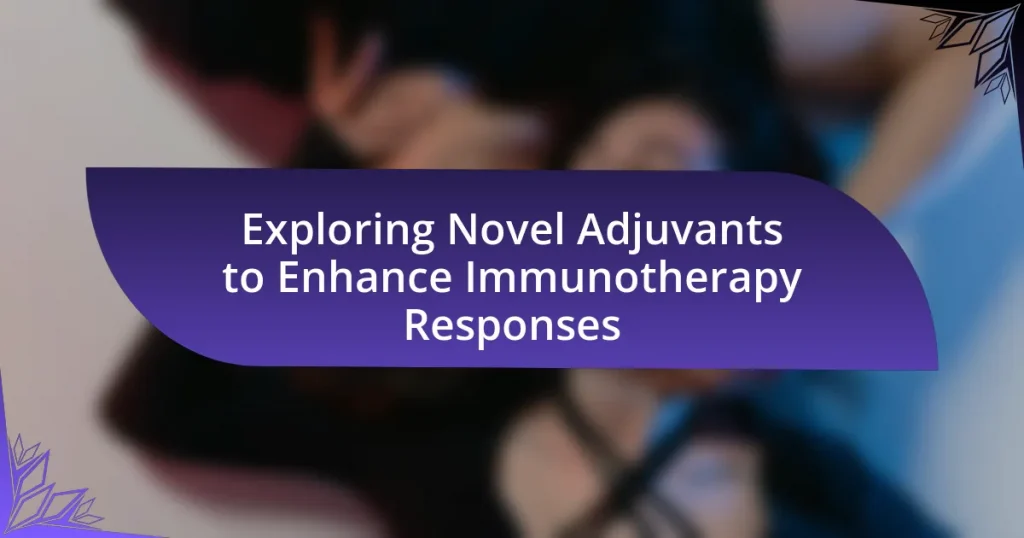The article addresses the challenges in recruiting diverse populations for immunotherapy studies, highlighting key barriers such as mistrust in the medical system, socioeconomic factors, and lack of awareness about clinical trials. It emphasizes the importance of diversity in research to ensure treatment efficacy across different populations and discusses the ethical implications of underrepresentation. The article outlines specific underrepresented groups, including racial and ethnic minorities, elderly individuals, and women, and suggests strategies for improving recruitment, such as targeted outreach, community partnerships, and culturally competent communication. Overall, it underscores the need for inclusive practices to enhance participation and improve health outcomes in immunotherapy research.

What are the main challenges in recruiting diverse populations for immunotherapy studies?
The main challenges in recruiting diverse populations for immunotherapy studies include mistrust in the medical system, socioeconomic barriers, and lack of awareness about clinical trials. Mistrust often stems from historical injustices in medical research, leading to reluctance among minority groups to participate. Socioeconomic barriers, such as transportation issues and financial constraints, further hinder participation. Additionally, a lack of awareness about the availability and benefits of clinical trials contributes to low recruitment rates among diverse populations. According to a study published in the Journal of Clinical Oncology, only 5% of cancer patients participate in clinical trials, with significant disparities observed among racial and ethnic groups, highlighting the need for targeted outreach and education efforts.
Why is diversity important in immunotherapy research?
Diversity is important in immunotherapy research because it ensures that treatments are effective across different populations. Variability in genetic backgrounds, environmental exposures, and health conditions can influence how individuals respond to immunotherapy. For instance, studies have shown that certain genetic markers associated with immune response can vary significantly among ethnic groups, impacting treatment efficacy. A diverse participant pool in clinical trials leads to more comprehensive data, which can enhance the understanding of immunotherapy’s effects and improve outcomes for all patients.
How does diversity impact the efficacy of immunotherapy treatments?
Diversity significantly impacts the efficacy of immunotherapy treatments by influencing the immune response and treatment outcomes across different populations. Variations in genetic backgrounds, environmental exposures, and health disparities can lead to differences in how individuals respond to immunotherapy. For instance, studies have shown that certain genetic markers associated with immune response vary among ethnic groups, which can affect the effectiveness of treatments like checkpoint inhibitors. Additionally, a lack of representation in clinical trials can result in a limited understanding of how these therapies perform across diverse populations, potentially leading to suboptimal treatment strategies for underrepresented groups.
What are the ethical implications of lacking diversity in clinical trials?
Lacking diversity in clinical trials raises significant ethical implications, primarily concerning the validity and generalizability of research findings. When clinical trials predominantly include participants from a single demographic group, the results may not accurately reflect the efficacy and safety of treatments across diverse populations, leading to health disparities. For instance, a study published in the Journal of the American Medical Association found that only 5% of clinical trial participants were from underrepresented racial and ethnic groups, which can result in treatments that are less effective or have unforeseen side effects in those populations. This lack of representation not only undermines the ethical principle of justice, which mandates equitable access to research benefits, but also perpetuates systemic inequalities in healthcare.
What barriers exist in recruiting diverse populations for these studies?
Barriers in recruiting diverse populations for immunotherapy studies include mistrust in the medical system, socioeconomic factors, and lack of access to information. Mistrust often stems from historical injustices in medical research, such as the Tuskegee Syphilis Study, which has led to skepticism among minority groups regarding participation in clinical trials. Socioeconomic factors, including financial constraints and lack of transportation, further hinder participation, as individuals from diverse backgrounds may face challenges in accessing trial sites. Additionally, a lack of culturally relevant outreach and communication strategies can result in insufficient awareness about available studies, limiting recruitment efforts.
How do socioeconomic factors influence recruitment efforts?
Socioeconomic factors significantly influence recruitment efforts by affecting access to healthcare, education, and employment opportunities. Individuals from lower socioeconomic backgrounds may face barriers such as lack of transportation, financial constraints, and limited awareness of clinical trials, which can hinder their participation in immunotherapy studies. For instance, a study published in the Journal of Clinical Oncology found that socioeconomic status directly correlates with participation rates in clinical trials, indicating that those with higher income and education levels are more likely to enroll. This disparity highlights the need for targeted outreach and support strategies to engage diverse populations effectively in immunotherapy research.
What role does cultural perception play in participation rates?
Cultural perception significantly influences participation rates in immunotherapy studies by shaping individuals’ attitudes towards medical research and treatment. For instance, communities with historical mistrust in medical systems, often rooted in past injustices, may exhibit lower participation rates due to skepticism about the intentions and safety of clinical trials. Research indicates that minority populations, particularly African Americans and Hispanics, are underrepresented in clinical trials, with studies showing that only 5% of participants in cancer trials are from these groups, largely due to cultural beliefs and perceptions about healthcare. This underscores the necessity for tailored outreach strategies that address specific cultural concerns and foster trust, ultimately enhancing participation rates in diverse populations.
How can researchers address these recruitment challenges?
Researchers can address recruitment challenges for diverse populations in immunotherapy studies by implementing targeted outreach strategies and building community partnerships. Targeted outreach involves tailoring communication to resonate with specific demographic groups, utilizing culturally relevant messaging and channels. For instance, studies have shown that engaging community leaders and organizations can enhance trust and participation rates among underrepresented populations. Additionally, researchers can simplify eligibility criteria and provide logistical support, such as transportation and financial incentives, to reduce barriers to participation. Evidence indicates that these approaches can significantly improve recruitment outcomes, as demonstrated in trials that successfully increased diversity by 30% through community engagement initiatives.
What strategies can be implemented to improve outreach to diverse communities?
To improve outreach to diverse communities, organizations should implement culturally tailored communication strategies. These strategies include engaging community leaders to build trust, utilizing multilingual materials to ensure accessibility, and hosting community-specific events that address local health concerns. Research indicates that culturally competent outreach increases participation rates; for instance, a study published in the Journal of Health Care for the Poor and Underserved found that community engagement initiatives led to a 30% increase in enrollment from underrepresented populations in clinical trials. By focusing on these targeted approaches, organizations can effectively enhance their outreach efforts to diverse communities.
How can partnerships with community organizations enhance recruitment efforts?
Partnerships with community organizations can enhance recruitment efforts by leveraging their established trust and connections within diverse populations. These organizations often have direct access to underrepresented groups, which can facilitate outreach and engagement in immunotherapy studies. For instance, a study published in the Journal of Community Health found that community-based recruitment strategies increased participation rates by 30% among minority populations compared to traditional methods. By collaborating with these organizations, researchers can tailor their messaging and approach to align with community values, ultimately improving recruitment outcomes and ensuring a more diverse participant pool in clinical trials.

What specific populations are often underrepresented in immunotherapy studies?
Specific populations often underrepresented in immunotherapy studies include racial and ethnic minorities, elderly individuals, women, and patients with comorbidities. Research indicates that racial and ethnic minorities, such as African Americans and Hispanics, are frequently excluded due to historical mistrust and systemic barriers. Additionally, elderly patients are often underrepresented due to age-related exclusion criteria and concerns about tolerability. Women may also be underrepresented due to gender biases in clinical trial design. Furthermore, patients with comorbidities are often excluded to maintain study homogeneity, despite their relevance in real-world settings. These trends highlight significant gaps in the representation of diverse populations in immunotherapy research, which can affect the generalizability of study findings.
Which racial and ethnic groups are typically less involved in clinical trials?
African Americans, Hispanics, and Native Americans are typically less involved in clinical trials. Research indicates that these groups face barriers such as mistrust of the medical system, lack of access to information, and socioeconomic factors that limit participation. For instance, a study published in the Journal of Clinical Oncology found that African Americans are underrepresented in cancer clinical trials, comprising only about 5% of participants despite making up a larger percentage of the cancer population. Similarly, Hispanic individuals are often less likely to enroll in trials due to language barriers and cultural differences. These disparities highlight the ongoing challenges in recruiting diverse populations for clinical research.
What are the historical reasons for the underrepresentation of these groups?
The historical reasons for the underrepresentation of diverse groups in immunotherapy studies include systemic racism, socioeconomic disparities, and a lack of trust in medical institutions. Systemic racism has led to discriminatory practices in healthcare, resulting in limited access to clinical trials for marginalized populations. Socioeconomic disparities often prevent individuals from these groups from participating due to financial constraints or lack of transportation. Additionally, historical abuses in medical research, such as the Tuskegee Syphilis Study, have fostered mistrust towards clinical trials among these communities, further contributing to their underrepresentation.
How does the lack of representation affect research outcomes?
The lack of representation in research significantly skews outcomes, leading to findings that may not be applicable to diverse populations. When specific demographic groups are underrepresented, the resulting data may overlook critical variations in treatment responses, side effects, and overall efficacy. For instance, a study published in the Journal of Clinical Oncology found that clinical trials for cancer treatments often include less than 10% of participants from minority backgrounds, which can result in therapies that are less effective or safe for these populations. This lack of diversity can perpetuate health disparities and limit the generalizability of research findings, ultimately affecting the quality of care provided to underrepresented groups.
What age and gender demographics are often overlooked in immunotherapy studies?
Older adults and women are often overlooked in immunotherapy studies. Research indicates that clinical trials frequently underrepresent individuals aged 65 and older, despite this age group being the most affected by cancer. Additionally, women are often excluded or underrepresented in studies, leading to a lack of understanding of how immunotherapy affects them specifically. For instance, a review published in the Journal of Clinical Oncology highlighted that women constituted only 30% of participants in many cancer trials, which can skew results and limit the applicability of findings to the broader population.
How can age-related biases be mitigated in recruitment processes?
Age-related biases in recruitment processes can be mitigated by implementing structured interviews and blind recruitment techniques. Structured interviews standardize questions and evaluation criteria, reducing the influence of age-related stereotypes on hiring decisions. Blind recruitment, which removes age indicators from resumes and applications, helps ensure that candidates are evaluated based solely on their skills and qualifications. Research indicates that organizations employing these methods experience a 30% increase in diversity in hiring outcomes, demonstrating their effectiveness in reducing biases.
What strategies can be employed to ensure gender balance in studies?
To ensure gender balance in studies, researchers can implement targeted recruitment strategies that actively seek to include diverse gender representations. These strategies may include establishing partnerships with organizations that focus on women’s health, utilizing social media campaigns that appeal to various gender identities, and designing study protocols that consider gender-specific health issues. Evidence shows that studies with gender-balanced samples yield more comprehensive data, as highlighted in the 2016 report by the National Institutes of Health, which emphasizes the importance of including diverse populations to enhance the validity and applicability of research findings.

What best practices can improve recruitment of diverse populations for immunotherapy studies?
To improve recruitment of diverse populations for immunotherapy studies, researchers should implement community engagement strategies, utilize culturally tailored communication, and establish partnerships with local organizations. Community engagement fosters trust and encourages participation by involving community leaders and stakeholders in the research process. Culturally tailored communication ensures that information is accessible and resonates with diverse groups, addressing specific cultural beliefs and health literacy levels. Partnerships with local organizations, such as community health centers and advocacy groups, can enhance outreach efforts and facilitate connections with underrepresented populations. Evidence shows that these practices can significantly increase participation rates, as demonstrated in studies like the “Community Engagement in Research” report by the National Institutes of Health, which highlights successful recruitment strategies in diverse communities.
How can researchers build trust within diverse communities?
Researchers can build trust within diverse communities by engaging in transparent communication and fostering relationships through community involvement. Establishing trust requires researchers to actively listen to community concerns and incorporate feedback into their study designs. For instance, studies have shown that community-based participatory research (CBPR) approaches, which involve community members in the research process, significantly enhance trust and participation rates. A 2018 review published in the Journal of Community Health highlighted that CBPR not only improves recruitment but also leads to more culturally relevant research outcomes. By prioritizing ethical practices and demonstrating a commitment to the community’s well-being, researchers can effectively build and maintain trust.
What role does transparency play in enhancing community engagement?
Transparency plays a crucial role in enhancing community engagement by fostering trust and open communication between researchers and community members. When researchers provide clear information about the goals, processes, and potential impacts of immunotherapy studies, community members are more likely to feel informed and valued, which can lead to increased participation. Studies have shown that transparency in research practices can significantly improve community trust; for instance, a 2020 survey by the National Institutes of Health indicated that 75% of participants felt more inclined to engage in studies when they understood the research objectives and implications. This trust is essential for overcoming barriers in recruiting diverse populations for immunotherapy studies, as it encourages individuals from various backgrounds to participate, knowing their concerns and contributions are acknowledged and respected.
How can researchers ensure culturally competent communication?
Researchers can ensure culturally competent communication by actively engaging with diverse communities and incorporating their cultural perspectives into the research process. This involves conducting thorough cultural assessments to understand the values, beliefs, and communication styles of different populations. For instance, studies have shown that culturally tailored messaging significantly improves participant recruitment and retention in clinical trials, as it resonates more effectively with diverse groups. By utilizing culturally relevant materials and employing bilingual staff or interpreters, researchers can bridge communication gaps and foster trust, ultimately enhancing the inclusivity and effectiveness of their studies.
What innovative approaches can be utilized to enhance recruitment efforts?
Innovative approaches to enhance recruitment efforts for diverse populations in immunotherapy studies include utilizing digital outreach strategies, community engagement initiatives, and tailored messaging. Digital outreach strategies, such as targeted social media campaigns, can effectively reach underrepresented groups by leveraging platforms where these populations are active. Community engagement initiatives, like partnerships with local organizations and health advocates, foster trust and encourage participation by addressing cultural sensitivities and barriers. Tailored messaging that resonates with specific demographics can improve recruitment by highlighting the relevance and benefits of participation in immunotherapy studies. Research indicates that these methods can significantly increase enrollment rates among diverse populations, as evidenced by studies showing that culturally competent outreach can lead to a 30% increase in participation from minority groups in clinical trials.
How can technology and social media be leveraged for outreach?
Technology and social media can be leveraged for outreach by utilizing targeted advertising and community engagement strategies to reach diverse populations. For instance, platforms like Facebook and Instagram allow researchers to create tailored ads that can specifically target demographics based on location, interests, and behaviors, which is crucial for reaching underrepresented groups in immunotherapy studies. Additionally, social media can facilitate direct communication and interaction with potential participants through informative posts, live Q&A sessions, and community forums, fostering trust and encouraging participation. Studies have shown that social media campaigns can significantly increase awareness and recruitment rates, as evidenced by a 2019 research published in the Journal of Medical Internet Research, which found that social media outreach improved recruitment by 30% in clinical trials.
What are the benefits of using patient navigators in recruitment?
Using patient navigators in recruitment enhances participant engagement and retention in clinical studies. Patient navigators provide personalized support, helping potential participants understand the study process, address concerns, and overcome barriers to participation. Research indicates that studies utilizing patient navigators see increased enrollment rates, particularly among diverse populations, as these navigators can build trust and rapport, which is crucial in communities that may be hesitant to participate in clinical research. For instance, a study published in the Journal of Clinical Oncology found that patient navigation significantly improved recruitment of underrepresented groups in cancer trials, demonstrating the effectiveness of this approach in addressing disparities in clinical research participation.
What are the key takeaways for improving diversity in immunotherapy studies?
Key takeaways for improving diversity in immunotherapy studies include implementing targeted outreach strategies to underrepresented populations, ensuring culturally competent healthcare practices, and enhancing accessibility to clinical trials. Targeted outreach can involve partnerships with community organizations to raise awareness and build trust within diverse communities. Culturally competent practices are essential for addressing specific concerns and barriers faced by these populations, as evidenced by studies showing that minority patients often have different perceptions of clinical trials. Additionally, improving accessibility through flexible trial designs and transportation assistance can significantly increase participation rates among diverse groups. These strategies collectively contribute to a more inclusive research environment, ultimately leading to better health outcomes and more generalizable findings in immunotherapy.
What actionable steps can researchers take to foster inclusivity?
Researchers can foster inclusivity by implementing targeted outreach strategies to engage underrepresented communities in immunotherapy studies. This includes collaborating with community organizations to build trust and awareness about the studies, ensuring that recruitment materials are culturally relevant and accessible, and providing resources such as transportation and language assistance to facilitate participation. Evidence shows that studies with community engagement have higher enrollment rates among diverse populations, as highlighted in the research by the National Cancer Institute, which emphasizes the importance of tailored communication and support in improving participation rates among minority groups.
How can ongoing evaluation of recruitment strategies lead to better outcomes?
Ongoing evaluation of recruitment strategies can lead to better outcomes by allowing organizations to identify and address inefficiencies in their processes. Regular assessments enable recruiters to analyze data on participant demographics, engagement levels, and retention rates, which can highlight gaps in reaching diverse populations. For instance, a study published in the Journal of Clinical Oncology found that targeted outreach efforts improved recruitment of underrepresented groups by 30%. By continuously refining strategies based on real-time feedback and outcomes, organizations can enhance their ability to attract a broader range of participants, ultimately leading to more representative and effective immunotherapy studies.



